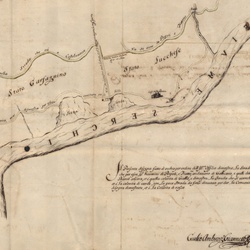The watercourses
Valle del Serchio. Più vicino a te

The valleys etched by the river Serchio and its tributaries not only offered a method of communication through the land routes but these watercourses, turbulent and unreliable, were also used to transport goods to Lucca, especially wood for building, which was floated along the river. The traffic was intense and supplied both the town’s building sites and the naval construction yards, for which the best logs were reserved.
The places chosen to load timber onto the Serchio were few. They had to be where the river ran less violently, with a wide bed and beaches where the logs could be stacked, or places were it was easy to slide the logs into the water. The selected districts were the Gittatoio di Riana, Ponte all’Ania, Ponte alla Maddalena, the San Romano plain, Pian dell Rocca, Anchiano, Diecimo and Chifenti.
Along the main watercourses, wide rafts were used, steered by experts called “magliatori” or “trainatori”, who were paid handsomely. The vehicular traffic of goods took place from July to October, when the water level and the currents did not impede the work. Particular attention had to be paid to the seasons since heavy rainfall could result in disastrous floods, following which a large part of the loads stored on the banks might be lost.
The cutting and transporting of the logs was so important that the General Council of the Municipality of Lucca and the Elders promulgated edicts and regulations to stamp out speculation and fraud. Indeed, it often happened that the communities assigned the work tried to make illegal profits by withholding timber, shortening the logs or demanding exorbitant amounts for transport by hand.
From the fifteenth to the nineteenth century, many laws were introduced in the attempt to regulate this specialised traffic which, since it involved naval shipyards, was a strategic matter. An example is the Florentine state exploiting to the utmost the timber resources near Barga, where the trunks of beech trees were floated in part to Pisa and in part to the Arsenals on the Mologno Plain, to make the oars required to drive the galleys of war. The suppling of the “Hall of Oars of the Great Duchy” was carried out along a purpose-built road called "The road of the Oars".
For smaller goods, land transport was preferable given the turbulent nature of the river Serchio. Needing to cross the river where there were no bridges meant identifying a district with calm waters and accessible banks in order to extend a rope from one bank to the other so that a raft could be carefully steered for an easy crossing. One of these was located at the town of La Barca, a place name retained until the end of the fourteenth century that openly proclaimed the presence there of a ferry. The Florentine territory of the Vicar of Bargo was united with the Lucchese land of Gallicano, paving the way for contacts, often stormy, between the two powers.



